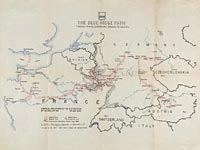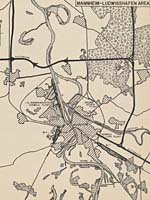
RESCUE FLAG
Helen McGuirk, although only a teenager during World War II,
was very active in the USO during and after the war. She made
friends with many servicemen who sent her war-related memorabilia
such as the rescue flag displayed here. Airmen who served in
the China-Burma-India Theater used this flag in case they were
shot down. In seven languages, the flag identifies the carrier
as an American flyer who needs help and explains that the United
States government will compensate for any help given. Airmen
used similar flags in the European Theater of Operations. Helen
McGuirk donated the collection.

"Window
Banner,"
1942-1944.
Flag.
Clare Marie Crane Collection,
Veterans History Project (87)
|
STARS SHINING YET SOMBER
During World War II, USO hostess Clare Marie Crane's
husband and two brothers served in the military. Crane
placed a flag in her window with three stars symbolizing
her three loved ones serving in the military-a common
practice during this time. Her husband Lieutenant Herbert
George Johns, died of leukemia overseas just ten days
after the initial diagnosis. When Crane received the
telegram that her husband had died she did not know he
had been ill. Upon learning of his death, she placed
an embroidered gold star over her husband's star on the
flag. Clare Marie Crane donated the collection.
|
HOMESPUN AMERICA
M. Gertrude Hawkey's brother, Jeffrey D. Conway, was stationed
in Polzig, Germany, after the war ended in Europe. Conway and
others in his company wanted an American flag so they asked the
local tailor in Polzig to help them create one. They used an
old Nazi flag for the red, bed sheets for the white, and petticoat
material for the blue. Three weeks later, an American flag waved
in Polzig. Conway's letter explains the making of the flag in
more detail. The photograph shows the Hawkey family with the
flag. M. Gertrude Hawkey presented her brother's handmade American
flag to Marathon Music and Video Representatives Lanny Lee and
Gary Rhay for donation to the Library of Congress.

"The
Blue Ridge Path,"
May 22, 1945.
Map.
LeRoy Paul Baker Collection,
Veterans History Project (78)
|
THE BLUE RIDGE PATH
Technician LeRoy Paul
Baker served in the 80th Infantry Division, nicknamed
the "Blue Ridge Division," that
compiled and drew the displayed map, showing the "Blue
Ridge Path," the route the division followed through
France, Luxembourg, Germany, and Austria. Note the attack
arrows into Europe and the returning arrows leaving Europe.
Senator Richard Lugar donated the LeRoy Paul Baker Collection
along with more than 1600 other veterans' collections.
|
ENGLAND AND BEYOND
First Lieutenant Benjamin Witten served as navigator
on bombing raids for the Army Air Force during World
War II. This map details the distance from England to
bombing locations in Europe. Rochelle G. Witten, daughter
of Benjamin Witten, donated the collection.
|

"Raids,"
July 1942.
Map.
Benjamin Witten Collection,
Veterans History Project (79)
|
STAFFORD MAPS: A VIEW FROM ABOVE
Staff Sergeant Horace Stafford served in the Army Air Force
Medical Department during World War II. He was stationed at the
Eighth Air Force Headquarters in Pinetree, England. The displayed
maps of Cologne, Frankfurt, and Mannheim-Ludwigshafen show three
German cities that Stafford flew over during the Victory Air
Flight in May 1945. The Victory Air Flight highlighted places
that Allies bombed during World War II. Cologne was a major industrial
and transportation center for the Third Reich. Frankfurt was
an industrial location where key railroads intersected. Mannheim-Ludwigshafen
produced valued commodities, such as oil and rubber. Horace Stafford
donated the collection.
JOHN MANGER: BRIDGING THE GAPS OF WAR
In September 1944, John Philip Manger, Captain, U.S. Army, 164th
Engineer Battalion, was assigned the mission of constructing
a permanent class 70 bridge at Dinant, Belgium, across the Meuse
River. There were no construction materials available in the
vicinity of the bridge site, no plans for the bridge, and no
survey had been conducted. The materials reconnaissance, design
drawing, surveying of the site, and construction of the bridge
all began simultaneously. The reports on display document the
building of the bridge. Douglas Manger, the son of John Manger,
donated these reports, which are only part of his father's extensive
collection.
 |
 |
 |
Drawing:
Traffic circulation at Dinant Bridge (Belgium).
Drawings traced and reproduced by 164th Engineer Combat Battalion, 1st
Army, 1944;
Report on Dinant Bridge, Dinant,
Belgium. Built by 164th Engineer Combat Battalion,
ca. 1944;
Drawing: Timber Bridge-Meuse
River, Dinant Belgium, Headquarters,
U.S. Army 164th Engineer Battalion, Corp of Engineers,
First Army Drawings, ca. 1944.
John Manger Collection, Veterans History Project (82-84)
|

"The
Route of The Ninth Division Thru
The NATOUSA & ETOUSA,"
November 8, 1942-August 1945.
Map.
Alfred R. Benoit Collection,
Veterans History Project (81)
|
THE ROUTE OF THE NINTH DIVISION
Technical Sergeant Alfred R. Benoit served in the 9th
Infantry Division. Benoit traveled extensively throughout
Europe, as shown in this map that illustrates the routes
taken by his division during World War II. The titles "NATOUSA" and "ETOUSA" stand
for the "North African Theatre Operation" and the "European
Theatre Operation," with U.S.A. added to each. Noella
Lucy Benoit, wife of Alfred Benoit, donated the collection.
|
AIR STRIKE AND RETURN TO BASE
Lieutenant Colonel Richard Pierson served in the Air
Force during the Korean War and the Vietnam War. During
the Vietnam War, Pierson was assigned to Bien Hoa Air
Base in Vietnam. On August 17, 1963, Pierson was called
to refuel his plane at Pleiku Air Base and then strike
a force of Viet Cong who had attacked a Special Forces
outpost the previous night. Pierson destroyed several
camouflaged locations where the Viet Cong were hiding
and then flew back to Bien Hoa Air Base. The target map
and briefing information shown here are the originals
that Pierson used on this mission.
|

"Air
Commando Close Air Support
Mission for Special Forces,"
August 17,1963.
Map.
Richard Pierson Collection,
Veterans History Project (85) |
|
















